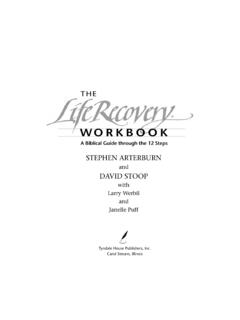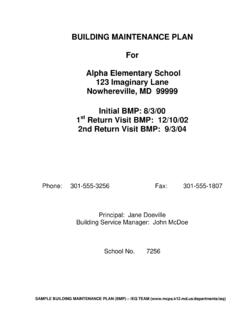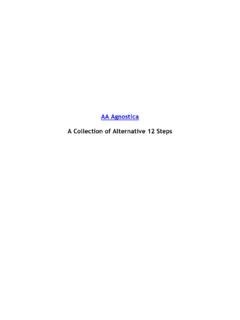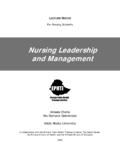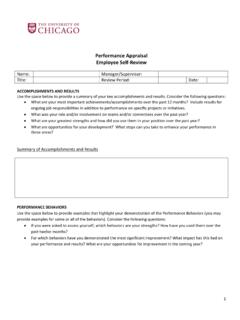Transcription of The Proactive Twelve Steps - Weebly
1 To navigate forward or back, use the arrows in the Acrobat frame. Serge Prengel The Proactive Twelve Steps 12 steps workbookPROACTIVE CHANGE The Proactive Twelve Steps 12 steps workbook By Serge Prengel Copyright 2006 Serge Prengel - All rights reserved Published by Proactive Change - New York, NY introduction the Proactive 12 steps Personally and professionally, I am interested in how we make changes in our lives. I have long been interested in the Twelve Steps . Millions of people credit the Steps for their recovery from addiction to alcohol and other substances. I do not have personal or professional experience in this area. So, you may wonder, how are these Steps relevant to what I do? The original Twelve Steps were written by the people who started Alcoholics Anonymous. However, only the first step of says something about the struggle with alcohol.
2 The other Steps provide a framework to, essentially, & quot ;get a life& quot ;. There's a logic to this: 's focus is on dealing with powerlessness and empowerment. One of their key insights is that the best way to abandon destructive habits is to have something better to look forward to. This is why they describe a path toward self-discovery and personal growth. This path can be a useful tool for your own & quot ;hero journey& quot ;, the process of becoming who you really are. I believe that, as we develop a deeper sense of who we truly are, we increase our ability to lead a more fulfilling life. This, in turn, makes it easier to make difficult changes. In this book, you will find the traditional wording of the 12 steps together with an original approach: the & quot ; Proactive 12 steps & quot ;. With this new wording, and the accompanying commentary, my goal is to describe the Steps as a self-directed process as opposed to a mystical process in which change somehow happens to you.
3 This is about how you can take a Proactive role in your growth as a person. I originally wrote these Steps for people who, like me, were not part of the Twelve Steps culture. Over time, many people involved in 12 steps recovery have told me that they find inspiration in these Proactive Steps : Not as a replacement for the wording they are so familiar with, but as a way to gain a new perspective on it. In any case, I am inviting you to see the Proactive Steps as an invitation to a dialogue, as opposed to a directive that is carved in stone. Let yourself explore what comes up for you as you go through the Steps . Take the time to digest each step before moving on to the next. step one 1 > > > > > > > > > > > I realize I m stuck. It makes no sense to keep trying to solve my problems with & quot ;solutions& quot ; that aren't working. Original wording (AA): We admitted we were powerless over alcohol--that our lives had become unmanageable.
4 Codependency: We admitted we were powerless over others - that our lives had become unmanageable. Generic version: We admitted we were powerless over things we believed we should control -- that our lives had become unmanageable. discussion 1 > > > > > > > > > > > step One: A new beginning Somebody once said: If the only tool you have is a hammer, you try to solve everything by hammering. Well, if the hammer is not solving the problem, it may very well be time to try something else. The problem is, you may feel that the hammer really should be that it will actually work if you just try a little There s nothing wrong with persistence. But step One introduces another consideration: accountability. It s not enough to just say: I believe it will work one day if I just keep trying. You need to set goals and deadlines. Not for the sake of putting pressure on but in order to face the reality of what is happening.
5 step One is looking squarely at reality. If what you re doing is not working, you acknowledge that. When you do, you are left with a feeling of emptiness you don t know what to do, or even whether there is a solution. It can be really scary. Surprisingly, the emptiness allows you to make room for new, unexpected ideas. Will these Steps work for me? Self-knowledge is helpful when you want to make changes in your life. The & quot ; Proactive 12 steps & quot ; will help you gain self knowledge. This, in turn, will help you make the changes you want. But don t just take my word for it. Keep track of what s happening. Periodically ask yourself whether you are making progress. This means that you need to give some thought to how you will define and evaluate progress. What if you re dealing with addiction? When people say that the Twelve Steps helped them deal with addiction, they do not mean that they just read the Steps .
6 They credit Twelve Steps meetings and the peer support they provide. Even peer support may not be enough. If your habits are endangering yourself or others, you may need to see a qualified professional or go to a rehab program. The first step is about facing the reality of your situation. It makes no sense to keep trying to solve problems with & quot ;solutions& quot ; that can't work. Whenever you realize this, you need to look for a different approach. In other words, the first step is not just the beginning of this process. It is an attitude. It is about staying grounded in reality as you keep track of your progress. step two > 2 > > > > > > > > > > I'm willing to let go of my usual ways, in the hope that this will help me see things from a broader perspective. Original wording (AA): Came to believe that a power greater than ourselves could restore us to sanity.
7 Discussion > 2 > > > > > > > > > > step Two: Letting go In step One, you realized the absurdity of clinging to & quot ;solutions& quot ; that don't work. Why then do you still cling to them? Probably because it feels somehow safer to have a & quot ;solution& quot ; (even one that doesn't work) rather than no solution at all. step Two is about letting go of these useless & quot ;solutions& quot ; to make room for new ones. Now, of course, there is absolutely no guarantee that you will find a solution that works. There's a big difference between hoping that things work out, vs. expecting and demanding that they do. It is quite possible that your fears will turn out to be realized. But, even then, you can keep the hope that there s still potential for happiness, even after your fears are realized. In other words, step 2 is about letting go of the old, narrow sense of who you are because it doesn't work (even though you somehow believe it should work).
8 A new perspective There once was an actor who couldn't use his voice the way he wanted to. At some point, he decided to stop trying so hard to make the sounds he wanted happen. Instead, he started paying close attention to how he made sounds - not just his voice per se, but also the movements of his body. He seemed to have lost his original focus on the voice as he kept experimenting with the movements of his body. But eventually he discovered that he now had an even better command of his body and voice than ever before. So he didn't just go back to the stage; he started teaching his method of movement to the public - it's known after his name, as the Alexander method. Feeling stuck as a starting point This story shows the difference between acknowledging your stuckness vs. falling into a spiral of despair. When you hit a really difficult spot, you probably start to feel overwhelmed.
9 You convince yourself that there's nothing you can do about it or about anything You start to believe that you are This is not necessarily true. Alexander's first step was to take stock of reality - the way things were, he simply couldn't be an actor any more. He was powerless in that sense. But he didn't jump to the hasty conclusion that all was lost. He stayed in the simple reality of observing what was happening. He kept trying to move consciously, focusing his attention on the mechanics and feelings of making He used his energy to deal with the specific problems at hand instead of using it to generate predictions of hopelessness and doom. Alexander's story is hardly unique. Way back from antiquity, there are examples of people who have overcome major obstacles through conscious attention. For instance, Demosthenes, born a stutterer, became one of Greece's most famous orators.
10 step three > > 3 > > > > > > > > > I shift my focus, from being fixated on my problems, to seeking a sense of wholeness and contentment in my life. Original wording (AA): Made a decision to turn our will and our lives over to the care of our Higher Power as we understood this Higher Power. discussion > > 3 > > > > > > > > > step Three: A leap of faith The Third step is a leap of faith - but not necessarily religious faith. What is it about? You decide to put your efforts into increasing your sense of wholeness and contentment in life. This is harder to do than it seems. It feels really scary to let go of the solution you think you have. It feels like, instead of dealing with the problem, you re giving up. The more stuck you are, the more you feel that the only way out is to try harder doing what you re already doing. What enables you to let go is the hope that it will work out.

